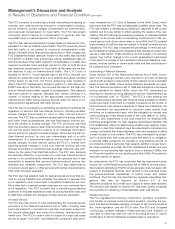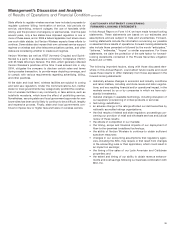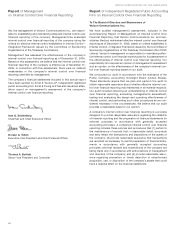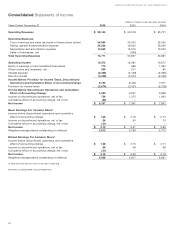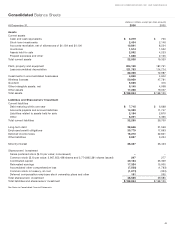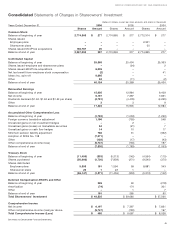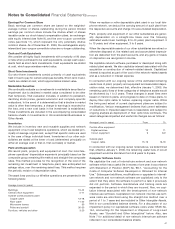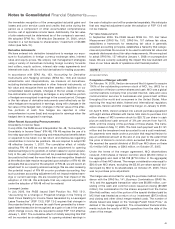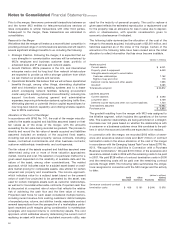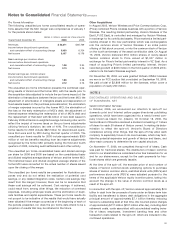Verizon Wireless 2006 Annual Report Download - page 48
Download and view the complete annual report
Please find page 48 of the 2006 Verizon Wireless annual report below. You can navigate through the pages in the report by either clicking on the pages listed below, or by using the keyword search tool below to find specific information within the annual report.
46
Notes to Consolidated Financial Statements
NOTE 1
DESCRIPTION OF BUSINESS AND SUMMARY OF
SIGNIFICANT ACCOUNTING POLICIES
Description of Business
Verizon Communications Inc. (Verizon) is one of the world’s leading
providers of communications services. Our wireline business pro-
vides telephone services, including voice, broadband video and data,
network access, nationwide long-distance and other communica-
tions products and services, and also owns and operates one of the
most expansive end-to-end global Internet Protocol (IP) networks.
We continue to deploy advanced broadband network technology,
with our fiber-to-the-premises network (FiOS) creating a platform with
sufficient bandwidth and capabilities to meet customers’ current and
future needs. FiOS allows Verizon to offer our customers a wide array
of broadband services including advanced data and television offer-
ings. Our IP network includes over 446,000 route miles of fiber optic
cable and provides access to over 150 countries across six conti-
nents, enabling us to provide next-generation IP network products
and Information Technology (IT) services to medium and large busi-
nesses and government customers worldwide.
Verizon’s domestic wireless business, operating as Verizon
Wireless, provides wireless voice and data products and other value
added services and equipment across the United States using one
of the most extensive wireless networks. Verizon Wireless continues
to expand our wireless data, messaging and multi-media offerings
for both consumer and business customers. NationalAccess is our
national wireless Internet service that offers customers access to
the internet, email and business applications with a laptop com-
puter. VCAST is a consumer wireless broadband multimedia service
that brings high-quality video, 3D games and music to a wide array
of new phones.
We have two reportable segments, Wireline and Domestic Wireless,
which we operate and manage as strategic business units and
organize by products and services. For further information con-
cerning our business segments, see Note 17.
Consolidation
The method of accounting applied to investments, whether consol-
idated, equity or cost, involves an evaluation of all significant terms
of the investments that explicitly grant or suggest evidence of con-
trol or influence over the operations of the investee. The
consolidated financial statements include our controlled sub-
sidiaries. Investments in businesses which we do not control, but
have the ability to exercise significant influence over operating and
financial policies, are accounted for using the equity method.
Investments in which we do not have the ability to exercise signifi-
cant influence over operating and financial policies are accounted
for under the cost method. Equity and cost method investments are
included in Investments in Unconsolidated Businesses in our con-
solidated balance sheets. Certain of our cost method investments
are classified as available-for-sale securities and adjusted to fair
value pursuant to the Financial Accounting Standards Board (FASB)
Statement of Financial Accounting Standards (SFAS) No. 115,
Accounting for Certain Investments in Debt and Equity Securities.
All significant intercompany accounts and transactions have been
eliminated.
We have reclassified prior year amounts to conform to the current
year presentation.
Discontinued Operations, Assets Held for Sale, and Sales of
Businesses and Investments
We classify as discontinued operations for all periods presented
any component of our business that we hold for sale or dispose of
that has operations and cash flows that are clearly distinguishable
operationally and for financial reporting purposes from the rest of
Verizon. For those components, Verizon has no significant contin-
uing involvement after disposal and their operations and cash flows
are eliminated from Verizon’s ongoing operations. Sales of signifi-
cant components of our business not classified as discontinued
operations are reported as either Sales of Businesses, Net, Equity
in Earnings of Unconsolidated Businesses or Other Income and
(Expense), Net in our consolidated statements of income.
Use of Estimates
We prepare our financial statements using generally accepted
accounting principles (GAAP), which require management to make
estimates and assumptions that affect reported amounts and dis-
closures. Actual results could differ from those estimates.
Examples of significant estimates include the allowance for doubtful
accounts, the recoverability of plant, property and equipment, intan-
gible assets and other long-lived assets, valuation allowances on tax
assets and pension and postretirement benefit assumptions.
Revenue Recognition
Wireline
Our Wireline segment earns revenue based upon usage of our net-
work and facilities and contract fees. In general, fixed monthly fees
for local telephone, long distance and certain other services are billed
one month in advance and recognized the following month when
earned. Revenue from services that are not fixed in amount and are
based on usage are recognized when such services are provided.
We recognize equipment revenue for services, in which we bundle
the equipment with maintenance and monitoring services, when the
equipment is installed in accordance with contractual specifications
and ready for the customer’s use. The maintenance and monitoring
services are recognized monthly over the term of the contract as we
provide the services. Long-term contracts are accounted for using
the percentage of completion method. We use the completed con-
tract method if we cannot estimate the costs with a reasonable
degree of reliability.
Customer activation fees, along with the related costs up to but not
exceeding the activation fees, are deferred and amortized over the
customer relationship period.
Domestic Wireless
Our Domestic Wireless segment earns revenue by providing access to
and usage of our network, which includes roaming revenue. In gen-
eral, access revenue is billed one month in advance and recognized
when earned. Access revenue, usage revenue and roaming revenue
are recognized when service is rendered. Equipment sales revenue
associated with the sale of wireless handsets and accessories is rec-
ognized when the products are delivered to and accepted by the
customer, as this is considered to be a separate earnings process
from the sale of wireless services. Customer activation fees are con-
sidered additional consideration when handsets are sold to customers
at a discount and are recorded as equipment sales revenue.
Maintenance and Repairs
We charge the cost of maintenance and repairs, including the cost of
replacing minor items not constituting substantial betterments, prin-
cipally to Cost of Services and Sales as these costs are incurred.
VERIZON COMMUNICATIONS INC. AND SUBSIDIARIES



